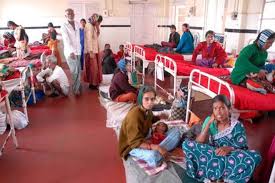Exclusive: India aims to revamp health scheme, lower costs after criticism

India’s health ministry has trimmed its cost estimates for extending its main public health programme by 25 percent after criticism from a federal think-tank over inefficiency and slow progress, according to government documents seen by Reuters.
The new estimate of $ 25 billion for a three-year extension of the flagship health programme, down from an initial figure of about $ 33 billion, comes as Prime Minister Narendra Modi pushes a multi-pronged agenda to revamp health services.
Planned reforms include streamlining spending and bureaucracy, slashing prices of life-saving drugs and medical devices, and nudging companies such as PepsiCo to make more healthy products.
To extend the National Health Mission to 2020, a think-tank led by Modi and the finance ministry in March told health officials to rework the original proposal with “realistic” budget expectations and to incorporate lessons from neighbours such as Nepal and Bangladesh, the documents show.
In response, the health ministry has resubmitted a plan with lower cost estimates and a list of targets to be achieved by 2020, including strengthening health infrastructure and reducing tobacco use.
The finance ministry, which will review the plan for approval this month, did not respond to a request for comment. The federal think-tank, NITI Aayog, declined to comment.
India’s National Health Mission is one of the world’s largest public health programmes. It provides free drugs and treatment to millions of rural poor and helped to eradicate polio.
But the public health system is in a shambles and India ranks poorly on key indicators – more than a million children die every year before reaching the age of five.
After focusing on maternal and child health for years, the programme will broaden priorities to tackle a growing burden of non-communicable diseases such as cancer, heart disease and diabetes, according to the documents.
The ministry has proposed increasing spending to treat such ailments from about $ 150 million this year to $ 1.5 billion in 2019-20, according to the new proposal which includes spending contributions from states.
The annual funding for strengthening the health system, including ramping up infrastructure and the work force, will more than double to about $ 3 billion in 2019-20, the documents show.
The new funding estimates are in line with a goal of raising health spending to 2.5 percent of gross domestic product by 2025, from 1.15 percent, a health ministry official said.
CRITICISM, REVAMP
The NITI Aayog was at first against the continuation of the National Health Mission, according to a record of government meetings reviewed by Reuters.
During a March meeting to discuss the proposal, the NITI Aayog’s health adviser said the programme needed a “course correction” and needed to improve standards.
The adviser, Alok Kumar, also pointed out that despite investment in the programme, public facilities were not attracting enough patients, documents showed.
Because rural hospitals in India are often dilapidated and suffer from a shortage of doctors, it is not uncommon for people to shun them and travel long distances in search of quality healthcare.
In the reworked plan, the ministry has prioritised out-patient departments, and aims to reduce premature mortality from cancer or heart ailments by a tenth and cut tobacco use by 7 percent by 2020, the documents showed.
Kumar pointed out in the March meeting that Bangladesh and Nepal had performed “better with even lower resources”. Kumar declined to comment.
Data from World Health Organization shows that Nepal, for example, had an under-five mortality ratio of 35.8 per 1,000 births, compared with India’s ratio of 47.7.
Health officials acknowledged in the meeting that results had yet to achieve levels of neighbouring countries.




